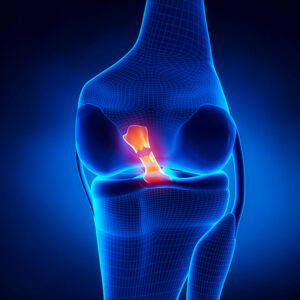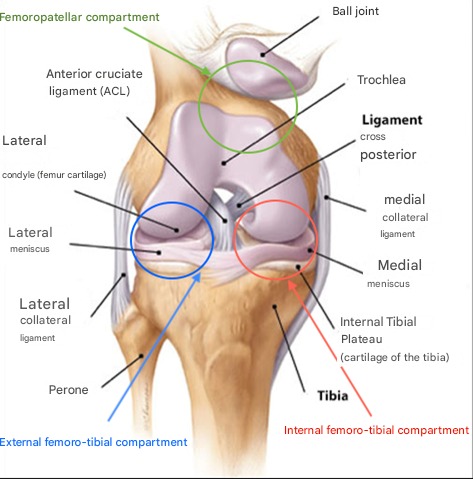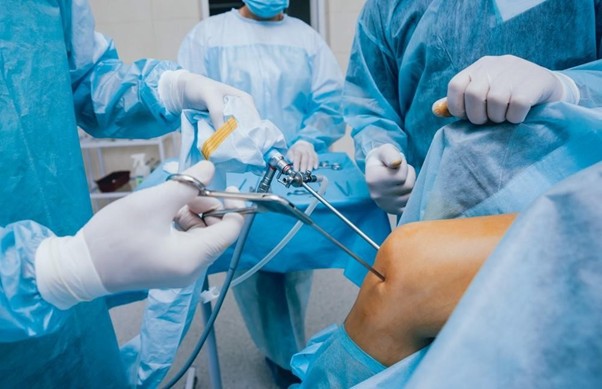An anterior cruciate ligament (ACL) rupture is a common injury that can affect both athletes and less active individuals. In both cases, it is a significant condition that should not be underestimated. Depending on the severity, it may require surgical intervention followed by several months of rehabilitation. With more than 50,000 surgeries performed annually in France and at least 200,000 in the United States, ACL injuries impact a large number of people. Understanding the causes, symptoms, and treatment steps is essential for optimal recovery. This article will guide you through the key aspects of ACL surgery and the necessary care to restore proper joint function.
Causes and Symptoms of an ACL Rupture
Knee mobility is maintained by four main types of ligaments, each playing a specific role in joint stability:
Anterior Cruciate Ligament (ACL): Located in the center of the knee, it prevents the tibia from moving forward relative to the femur and controls excessive rotational movements of the knee.
Posterior Cruciate Ligament (PCL): Positioned behind the ACL, it prevents the tibia from sliding backward relative to the femur.
Collateral Ligaments (Medial and Lateral):
Medial Collateral Ligament (MCL): Found on the inner side of the knee, it prevents excessive outward movement (valgus).
Lateral Collateral Ligament (LCL): Located on the outer side of the knee, it prevents excessive inward movement (varus).
These four ligaments work together to stabilize the knee in all directions and withstand the forces exerted during daily and athletic activities. A rupture of any of these ligaments results in partial disability, potentially compromising physical and sports activities.
Knee anatomy
Causes of ACL Rupture
An ACL rupture often results from a sudden or forceful movement, such as an abrupt change in direction, a poorly executed jump landing, a direct impact on the knee, or an uncontrolled hyperextension (e.g., “kicking into the air”). This injury typically occurs due to significant trauma. Sports like football, rugby, skiing, and basketball pose a high risk due to their intense demands on knee stability. However, ACL ruptures can also result from more minor incidents, such as a misstep or an awkward landing while walking.
Symptoms of an ACL Rupture
Symptoms appear immediately following the injury, with the most common being:
Sudden, sharp knee pain
A sensation of the knee “giving way”
An audible “pop” or “crack” at the time of injury
Loss of flexibility
Instability
Difficulty walking or bearing weight
Rapid and significant swelling due to hemarthrosis (blood accumulation in the joint)
If left untreated, an ACL rupture can lead to recurring instability episodes and an increased risk of meniscal damage and early osteoarthritis.
When Should ACL Surgery Be Considered?
ACL reconstruction surgery (ligamentoplasty) is not always mandatory. For older individuals who do not engage in intense physical activity, surgery may not be necessary, and recovery can occur naturally. However, for younger or highly active individuals, surgical intervention is essential, along with preoperative and postoperative rehabilitation, to restore full knee function. These steps are crucial for returning to sports requiring knee pivoting movements.
Before surgery, a preoperative consultation is conducted to determine the treatment plan. The surgeon performs a comprehensive knee examination to identify potential meniscal or additional ligament injuries. X-rays and MRIs provide detailed information to plan the procedure. During this consultation, the surgical approach, post-surgery expectations, contraindications, and recovery timeline are thoroughly explained.
Surgical Procedure
The most common technique for ACL reconstruction involves using a graft, typically harvested from the patellar tendon or hamstring tendons. The procedure follows these steps:
Anesthesia: General or local anesthesia is administered.
Graft Harvesting: The ligament graft is taken from the patient’s own tendons.
Arthroscopy: A small camera is inserted to visualize the inside of the joint and confirm ligament damage.
Graft Placement: Bone tunnels are drilled into the femur and tibia to secure the new ligament.
Fixation: Screws or anchor buttons are used to hold the graft in place.
The surgery typically lasts 40 to 60 minutes, and most patients can return home the same day.
Pre-Surgery Preparation: A Crucial Step
Preparing the knee before ACL surgery is essential for maximizing success. Before the operation, it is important to reduce knee inflammation and swelling while restoring a good range of motion. The surgeon may prescribe physical therapy sessions to strengthen the surrounding muscles, especially the quadriceps and hamstrings. Proper preparation helps prevent postoperative complications, such as joint stiffness, and facilitates a faster recovery. In cases of severe knee damage involving menisci or collateral ligaments, emergency surgery may be required.
Timeframe Between Rupture and Surgery
Preoperative rehabilitation usually lasts 3 to 6 weeks, depending on the severity of the injury and swelling. The goal is to restore a normal range of motion before surgery, which reduces the risk of postoperative stiffness. Physical therapists tailor rehabilitation based on patient progress and set objectives.
Post-Surgery Rehabilitation
Rehabilitation after ACL surgery is a long process that can take up to 6 months. For sports involving pivot movements, recovery can extend to 8 to 10 months. The rehabilitation process consists of several stages:
Early Phase: Reducing pain and inflammation, regaining basic joint mobility.
Strengthening Phase: Gradual strengthening of the quadriceps and hamstrings while avoiding excessive stress on the graft.
Proprioception and Stability Phase: Restoring balance, coordination, and knee stability.
With proper medical guidance and adherence to rehabilitation protocols, most patients regain full mobility and return to their pre-injury activity levels.
FAQ: ACL Rupture
1. What is the function of the ACL?
The ACL is a crucial stabilizer of the knee, preventing the tibia from sliding forward relative to the femur and controlling excessive rotational movements. It plays a vital role in running, jumping, and sudden directional changes.
2. How painful is an ACL rupture?
The pain is typically severe and sudden, often described as a “tearing” sensation. It is frequently accompanied by an audible “pop,” significant swelling (hemarthrosis), and instability, making it difficult to bear weight.
3. How is an ACL rupture treated?
Treatment depends on severity and patient activity levels:
- Conservative Treatment: Suitable for less active individuals. Includes rest, physiotherapy, and possibly a knee brace.
- Surgical Treatment: Recommended for athletes and those needing high joint function. Involves ligament reconstruction with a graft, followed by intensive rehabilitation.
4. How long should one wait before ACL surgery?
Typically, surgery is performed 3 to 6 weeks after the injury. This allows swelling to subside, restores movement, and strengthens surrounding muscles, reducing the risk of postoperative stiffness. In severe cases, immediate surgery may be necessary.
5. What does ACL post-surgery rehabilitation involve?
Rehabilitation lasts between 6 and 9 months, with structured physical therapy sessions to optimize recovery and prevent re-injury.








